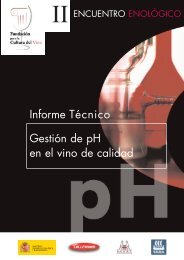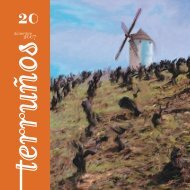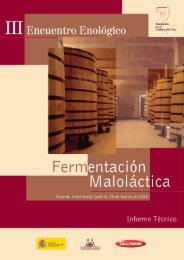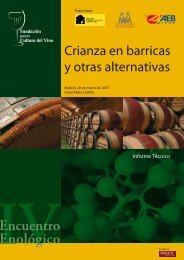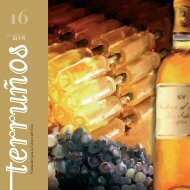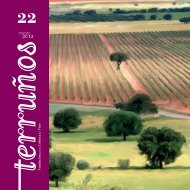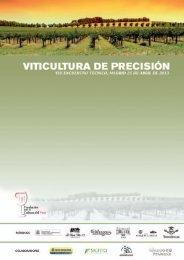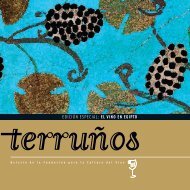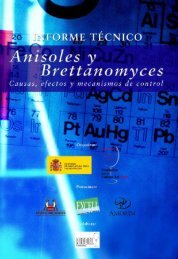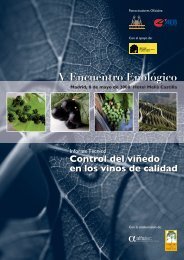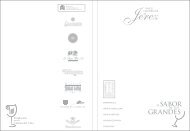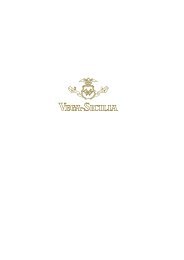Compuestos azufrados volátiles en vinos - Fundación para la ...
Compuestos azufrados volátiles en vinos - Fundación para la ...
Compuestos azufrados volátiles en vinos - Fundación para la ...
You also want an ePaper? Increase the reach of your titles
YUMPU automatically turns print PDFs into web optimized ePapers that Google loves.
Wh<strong>en</strong> the heat is on, yeast ferm<strong>en</strong>tation runs out of puff4(a)2007 20084(b)250120200100YAN conc<strong>en</strong>tration (mg/L)15010050YAN conc<strong>en</strong>tration SD (mg/L)806040200Region ARegion B0Region ARegion BFigure 4(a). The average YAN conc<strong>en</strong>tration in juices from two regions in South Australia for the 2007vintage and the 2008 vintage. For region A, n = 855 in 2007 and 1272 in 2008; for region B, n = 414 in 2007and 788 in 2008. Figure 4(b). Standard deviation in average YAN conc<strong>en</strong>tration from wine regions A and Bwas greater in 2008 than in 2007.conc<strong>en</strong>trations of inhibitors in the stuck wine, especiallyethanol. It is, however, critically important thatthe yeast not be starved of sugar or nitrog<strong>en</strong> duringthe stepwise acclimatisation procedure. The cultureshould also be briefly aerated at each step.Fresh yeast lees from successfully completed ferm<strong>en</strong>tscan also be useful for reinvigorating or restarting ferm<strong>en</strong>tswh<strong>en</strong> a re<strong>la</strong>tively small amount of residual sugarremains. A small addition of DAP and limited aeration,once the yeast is actively ferm<strong>en</strong>ting, promotesgood activity. This procedure provides a more conv<strong>en</strong>i<strong>en</strong>trescue option wh<strong>en</strong> yeast lees are avai<strong>la</strong>ble.Looking ahead, the AWRI is also alerting winemakersto the longer term effects of the 2008 heatwave. If redwines contain higher than usual amounts of residualsugar, and other nutri<strong>en</strong>ts added as ferm<strong>en</strong>tationstimu<strong>la</strong>nts, for example, the Brettanomyces/Dekkerayeast, can strike <strong>la</strong>ter in the maturation cycle or ev<strong>en</strong>after bottling of unfiltered wines. The higher alcoholconc<strong>en</strong>trations of 2008 wines might slow the growthof this spoiler meaning that greater vigi<strong>la</strong>nce shouldbe maintained further on down the process chain.Malo<strong>la</strong>ctic ferm<strong>en</strong>tation is also adversely affected byhigh alcohol levels such that Brettanomyces/Dekkerayeast can have a greater opportunity while the wineis unprotected by sulfites. The more alcohol tolerant<strong>la</strong>ctobacilli, which are capable of forming biog<strong>en</strong>icamines, will also thrive if the pH is not maintained below3.5, which is more favourable to O<strong>en</strong>ococcus. Theimpact of March 2008 might continue if not managedwith greater care due to the perturbed nature of thisyear’s wine chemistry.Stuck ferm<strong>en</strong>tations – what you can do• Increase the conc<strong>en</strong>tration of sulfur dioxideadded to grape bins. Th is will keep microbial‘bugs’ at bay and slow oxidation whichcan speed up at higher temperatures.• Sanitise bins betwe<strong>en</strong> loads. Cover binsduring transport to keep the sun off fruit.Clean all equipm<strong>en</strong>t to stop bacteria.• Choose yeast known to have high toleranceto alcohol and prepare it properly. Rehydrationof dried yeast with complex inactivatedyeast nutri<strong>en</strong>ts can be b<strong>en</strong>efi cial forstressful ferm<strong>en</strong>ts.• Dilute very high sugar musts with lowstr<strong>en</strong>gth juice (LSJ) before ferm<strong>en</strong>tation toimprove wine ba<strong>la</strong>nce, in accordance withwine statutory regu<strong>la</strong>tions.• Add tartaric acid as soon as must tanks aremixed and acidity levels are known. Checkagain after thorough mixing to <strong>en</strong>sure levelsare correct.• Take steps to reduce pH to improve the efficacy of sulfur dioxide. Lower pH increasesits antimicrobial and antioxidant properties.It controls the growth of unwantedmicroorganisms including <strong>la</strong>ctobacilli,some species of which are known to inhibityeast developm<strong>en</strong>t.• Monitor pH during ferm<strong>en</strong>tation and maintainit betwe<strong>en</strong> 3.4-3.5.• Measure YAN, preferably on the <strong>la</strong>st vineyardmaturity sample before harvest, sothat DAP can be added accordingly. If thisis not possible, add DAP as a precautionagainst low YAN, especially in dry years andwh<strong>en</strong> sugar conc<strong>en</strong>trations are high, sincemore YAN is needed by yeast to achieve lowresidual sugars.• Aeration of ferm<strong>en</strong>ts around the mid pointof ferm<strong>en</strong>tation can be highly b<strong>en</strong>efi cial byrestoring <strong>la</strong>gging rates and has no knownadverse impact on wine fl avour, rather itcan prev<strong>en</strong>t quality losses which sometimesresult from stuck ferm<strong>en</strong>tations.• Increasing juice turbidity consist<strong>en</strong>t withtarget wine style can considerably improvegrowth and ferm<strong>en</strong>tation activity.• Consider adding lysozyme to must of ferm<strong>en</strong>tsto control bacterial developm<strong>en</strong>t.80



